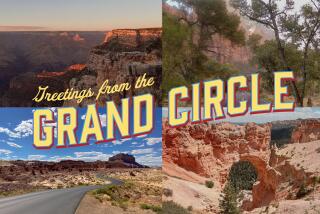Ending With an Appetite for a Few Last Discoveries
- Share via
PUERTO MONTT, Chile — They say that when traveling through southern Chile, where transportation is notoriously unreliable, you always know when you’ll leave but you never know when you’ll arrive. Only the second part is true. But at least it’s a gorgeous spot to sit and wait.
As our wander year approached the end, Andrea and I had two weeks to get from the bottom of South America to this port city, where we made plans for our return to San Diego. It’s a 1,000-mile trip as the crow flies, but we saw no crows in Chilean Patagonia. We instead followed a twisting, backtracking route, relying on buses, ferries, planes and minivans that run at three times: late, really late and tomorrow. But along the way, we glimpsed some of the most stunning scenery of the journey, gaping at pristine fiords, glacial peaks and dense native forests.
We left Ushuaia, the southernmost city in Argentina and the so-called end of the world, and traversed Tierra del Fuego by bus before crossing the Strait of Magellan on a ferry. After Ferdinand Magellan discovered this passage that links the Atlantic and Pacific oceans, his men were afraid to sail back through it, and it’s no wonder. The wind can blow you to New Zealand.
West of the Chilean city of Punta Arenas, we toured the Seno Otway Penguin Sanctuary, where 3,000 Magellanic penguins return every year to nest. The monogamous birds reclaim the same burrows each pair occupied the year before. We watched from beach-side blinds as penguins waddled single file from the sea. Down the road, protected gray foxes and ostrich-like nandus meandered in the tall, waving grass.
A six-hour bus ride north took us to the spectacular Torres del Paine National Park, where dramatic granite spires jut from the Patagonian steppe. Andean condors circled above, and austral parakeets darted below as we hiked trails flanked by glacier-fed lakes, fire-red notro flowers and herds of llama-like guanaco.
The road north through Chile ends at the park, so we returned to Punta Arenas and hopped a flight to Balmaceda, 440 miles south of Puerto Montt. That put us on the Carretera Austral (Southern Highway), a largely unpaved 600-mile track cut into a wilderness of temperate rain forests, cascading rivers and snowcapped mountains.
At the misnamed Puyuhuapi Channel (it’s a fiord), we crossed by boat to Termas de Puyuhuapi, an unpretentiously elegant wood-and-glass lodge set on a lonely peninsula crowned by lush peaks. The stress from our transportation woes melted away as we soaked in the thermal pools fronting the ice-blue fiord.
Another tardy bus delivered us a day late to the seaside town of Chaiten, where we met Nicolas La Penna, a guide who gives free music lessons to local youths. Some 12-year-old uniformed schoolboys dropped by La Penna’s house at lunchtime, and an impromptu jam session ensued in the front yard. La Penna dashed in and out of his house to retrieve ever more guitars made of native wood, and the boys played folk, rock, country and blues while holding schoolbooks between their knees. So we weren’t left out, La Penna hung large drums around our necks, and we tried to keep a beat.
In the morning, La Penna drove us north to Parque Pumalin, the largest privately held conservation area in the world. Funded by American millionaire Douglas Tomkins, the park covers nearly 750,000 acres, stretching from the Argentine border to the Pacific Ocean. A footpath wended through the virgin temperate rain forest, leading us to a wooden suspension bridge spanning a clear stream. On the other side, we gazed up at towering alerce trees, some as many as 4,000 years old. Our rustic and impeccably furnished cabin was built of reclaimed wood and looked out on sea lions fishing in Renihue Fiord.
The overnight ferry from Chaiten to Puerto Montt arrived a respectable five hours late. As the ship docked, it was hard to believe our journey was nearly over. We walked ashore and started the trek home. Like the penguins, we remembered the way.
NEXT WEEK: Home, sweet home.
More to Read
Sign up for The Wild
We’ll help you find the best places to hike, bike and run, as well as the perfect silent spots for meditation and yoga.
You may occasionally receive promotional content from the Los Angeles Times.






